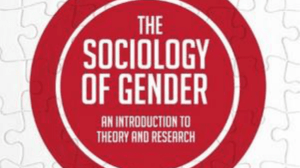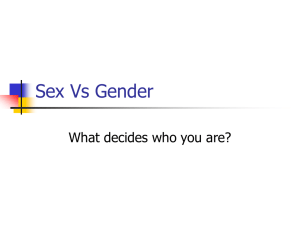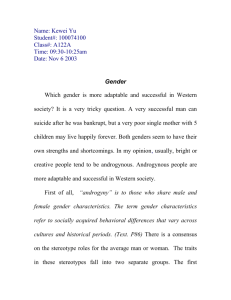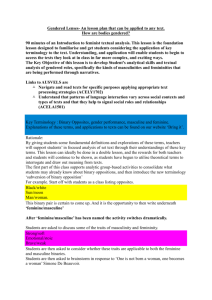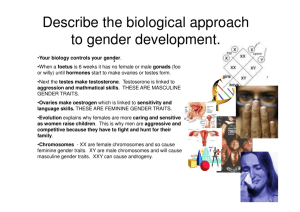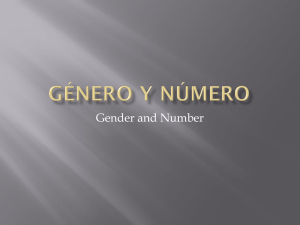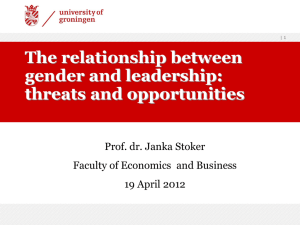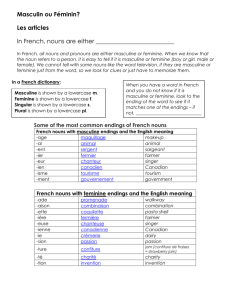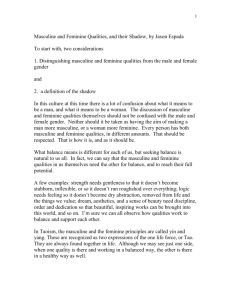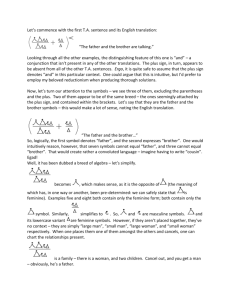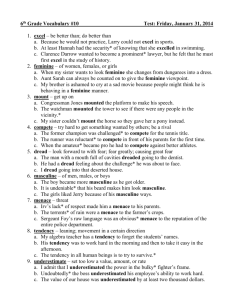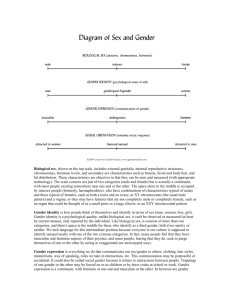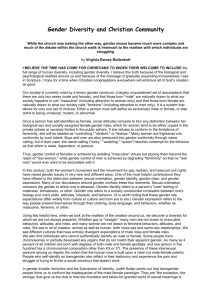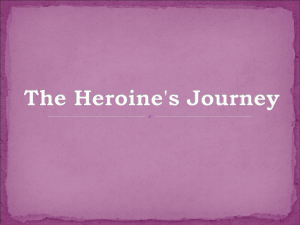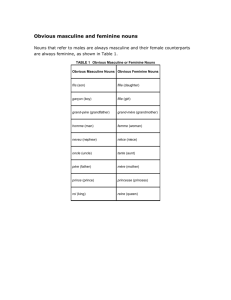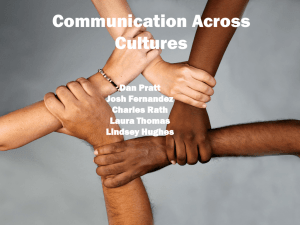GENDER IDENTITY
advertisement
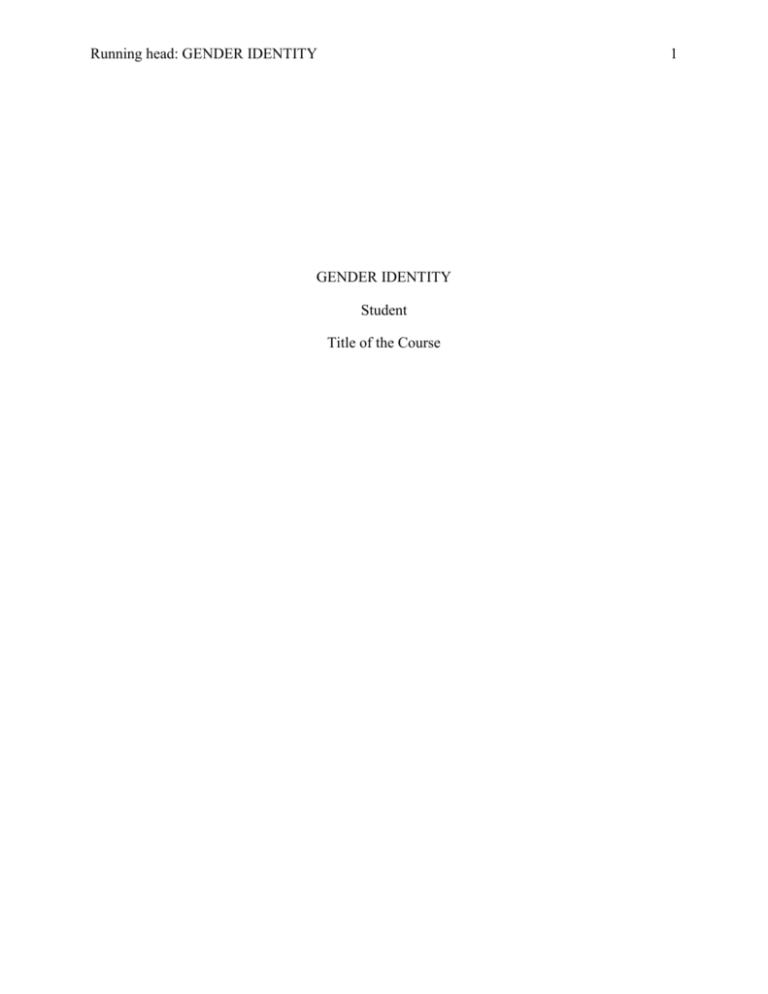
Running head: GENDER IDENTITY 1 GENDER IDENTITY Student Title of the Course GENDER IDENTITY 2 GENDER IDENTITY Gender identity refers to how much people see themselves as either masculine or feminine depending on what that means in society. Social norms actually decide what feminine or masculine really means--more than biology. Different societies have different expectations for which is dominant, or brave, or aggressive for instance. These are social definitions so it is possible for a person to be male biologically, but see himself as more feminine than masculine. Gender roles must be identified separately from merely concepts such as gender identities. Gender roles might mean a woman gets an outside-the-home-job, while a man might assume a domestic role. This would not necessarily involve gender identity. This is also true of gender stereotypes, which are just personality traits that people view as belonging to one gender, such as men being stoic, no matter what. Gender attitudes are also different from gender identity, in that attitudes are the way men or women think about certain things. All of these things can contribute or affect a person’s gender identity, but are not the same thing at all. From the time people are born, their attitudes towards their own gender start to be formed through social situations with their parents, siblings, friends, and authority figures. Established cultural concepts of male or female are transmitted to people through books, television, their church or even their families, but that does not mean they do not see themselves as not quite fitting exactly into that gender “model” as learned. A man may view himself as outside the culturally accepted masculine role because he sees himself as emotional and submissive. Or, a woman might feel that she is more rational and dominant in a masculine way, knowing the whole time that she is a female. This self-concept is people viewing themselves along a feminine-masculine continuum, either closer to one end than GENDER IDENTITY 3 the other or a mixture of the two. If this continuum was a straight line, feminine could be on one end and masculine on the other. Every person’s gender identity would fit somewhere on this line, either more towards the feminine side, more towards the masculine side, or anywhere along the continuum. This then, is their gender identity and their behavior goes along with it. If living in a society where men are aggressive, analytical, and unemotional, a woman who identifies with these traits would be closer to the masculine side of the continuum. In my own life, I was raised by my mother, a widow with five children. She had little formal education, but had a wealth of knowledge and strength in so many ways. My mother was strong, sometimes overbearing, and always took responsibility for the family. We always used to say that Mom “took no crap” from anyone. She had many menial jobs and did what she could to support the family. Yet, when she got ready to go to work, whether it was waiting tables or cleaning offices at the lumber yard, she always put on her lipstick, her hose, and a spritz of perfume. She and my father were ballroom dancers and sometimes she would put on the music and just dance around the living room. She loved to fish, and one of her prized possessions was a .22 rifle from her youth. I think I have taken a lot from the characteristics I saw in her. It is difficult for me to see myself in terms of masculine or feminine traits, because it is just “me.” However, I love to wear perfume, but I can bait my own hooks when I go fishing. I would like to think the “masculine” traits I possess are that I see myself as less “domestic” and would rather work outside the home and have someone else do the toilet cleaning and soup making. I do not really enjoy aggressive confrontation at all which may be considered less than GENDER IDENTITY masculine, but I will, if necessary, confront anyone at any time if I think it is required. I am a nurturer. I love babies, children of all ages and animals. Those commercials on television that show abused dogs and cats make me tear up every time. I want to take every abused child and animal home with me and care for them. Feminine? To sum up, I am like everyone else—some mix of masculine and feminine characteristics. And, sometimes it is not easy to balance it all. I do want children but I am not sure about spending my life cooking and changing diapers. I tend to avoid conflicts which appears to some that I am submissive, but in reality, when pushed enough, I turn into a very assertive woman. And, that often wins me the title of “bitch.” I am comfortable with my masculine and feminine characteristics. And, like most other people I assume, it is an ongoing task to take those traits and find your way as a person and a member of society without denying who you are. 4 GENDER IDENTITY 5 References Eagly, A. H. (1987) Sex Differences in Social Behavior: A Social-Role Interpretation. Hillsdale, N.J.: Lawrence Erlbaum Morawski, J. G. (1985) "The Measurement of Masculinity and Femininity: Engendering Categorical Realities." In Abigail J. Stewart and M. Brinton Lykes, eds., Gender and Personality: Current Perspectives on Theory and Research. Durham, N.C.: Duke University Press. Spence, J. T. (1994) "Masculinity, Femininity, and Gender-Related Traits: A Conceptual Analysis and Critique of Current Research." In B. A. Maher and W. Maher, eds., Progress in Experimental Research. San Diego: Academic Press.
